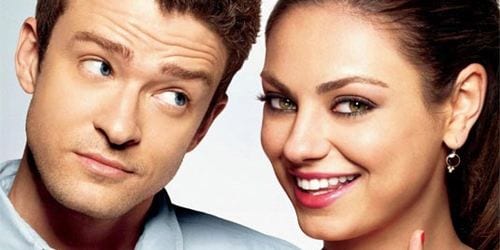
The big selling point surrounding Friends with Benefits is that it was marketed as a sexy, anti-romantic comedy. In the first 20 minutes, it’s apparent that this point is taken from the budding no-bullshit friendship between Dylan (played by Justin Timberlake), the Los Angeles bred freelance graphic designer, and Jamie (played by Mila Kunis), the fast talking headhunter who bags a glitzy New York job for him at GQ.
In the opening scene Jamie is described as “emotionally damaged” and Dylan is described as “emotionally unavailable” by their ex significant others. However, just as we become comfortable with the new friendship, and their sexual arrangement, like most friends with benefits relationships it begins to slowly unravel and reveal itself as the clichéd romantic comedy it advertises that it isn’t.
In the first half of the film there’s a few laughs in the fumbling mechanics of their sex scenes, and it’s enjoyable to watch these two banter in bed. In addition, they spend a lot of time ragging on the irony of the clichéd behavior of those who enjoy being in love, and the themes of romantic comedies in general. They seem to stumble around lost, but not really looking for love like most romantic comedies would have the leads do. They seem to be smart, edgy, career-driven people. These characters were made for the 21st century kids to relate to! They even both seem to hate things synonymously related with romantic comedies, like John Mayer love songs, and the typical cop out ending in the romantic comedy they watch early on the film (a hilarious montage of Rashida Jones and Jason Segel falling in love in “New York City” that just so happens to be shot in Los Angeles — see the irony here?)
The biggest problem with Friends With Benefits lies in the exhaustive amount of time the film takes to defiantly prove their characters as the people you wouldn’t normally see in romantic comedies, through redundant, almost trite dialogue (“Two people should be able to have sex the way they play tennis”!) and then completely drop the ball and fall back on the route of their clichéd predecessors.
You can almost forgive the over-the-top set up, that is until the halfway mark when we meet Jamie’s flighty hippy dippy ’70s-era mother (wonky character actress Patricia Clarkson), who just so happens to walk in on them having sex, and lingers long enough to hit on Timberlake. Presto! like magic Jamie’s apparent “mommy and daddy issues” are introduced, which clues the audience in on the fact that she really is a deeply misunderstood girl who’s just trying to figure herself out, and of course, all of her problems are going to be swept under the rug in exchange for a boyfriend, or at least that’s how this story is going. It’s also around that time that it’s hammered over the head how badly she seeks a real prince charming (yes, really, the film actually flings around that phrase).
The clichés roll on in the form of side characters, like Tommy (played by Woody Harrelson), Dylan’s older gay friend from work, who just so happens to be a Sports Editor (another point for irony there). Where in most romantic comedies the side character serves as a side for the plot, Tommy serves absolutely nothing to the film unless you count throwing out nonsense lines that perpetuate an already saturated flamboyant approach to portraying gay characters (“I ain’t taking no ferry unless it’s out to dinner and a show, bam!”)
However, there is some sort of saving grace about this film and that’s in the chemistry between Timberlake and Kunis. Timberlake, though he didn’t bring “sexy back” for this role, didn’t need to — that was Kunis’ job. This pairing was more interesting than any recent romantic comedy because of the role reversal. Within the first ten minutes there was no denying that Timberlake would be the typical “girl” character, the overly emotional, overly neurotic and hesitant character, while Kunis was the crass, in control butch. These strong character traits came in handy once Dylan brought Jamie to LA to meet his family. The most important introduction was that of his father who has Alzheimer’s (played by Richard Jenkins, who seems to do these types of roles in his sleep.) It’s in this chunk of time that we’re introduced to the charming history of Dylan’s childhood, which is where the real comedy comes in.
We learn the character had a stutter, is afraid of heights as a breaking and entering goes wrong and he’s lifted up in the air by a helicopter, and as a teen he had a hidden love for Kriss Kross, which eventually brings the true performer out in Timberlake as he breaks out into song. It’s the small moments that make the film redeemable, but of course these moments should have been expanded throughout the whole film. We got a a glimpse of how his story could have been built upon, but of course in the end, we only the shallow goals of the characters, and the bickering wrapped in a nice neat bow, topped off with a nice embellishment of a current pop song, and a flash mob. The anti-romantic comedy doesn’t work as well as anticipated, and if the characters were actually sitting in the theater, they would have walked out halfway through and wouldn’t have missed a beat.
For those who want to get an extra bang for your buck (pun intended), the special features on the Blu-ray are appropriately cheesy, with sides that feature a “sexy” featurette of the film, an over the top mob featurette, which shows the process of choreographing the scenes, and a pop-up trivia track.

![Call for Papers: All Things Reconsidered [MUSIC] May-August 2024](https://www.popmatters.com/wp-content/uploads/2024/04/all-things-reconsidered-call-music-may-2024-720x380.jpg)



